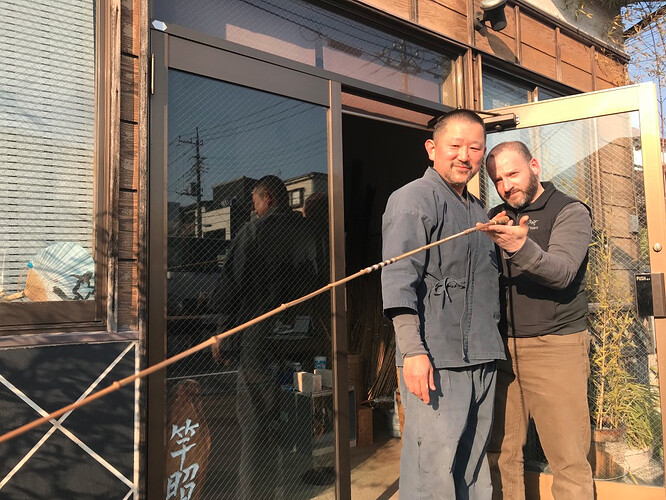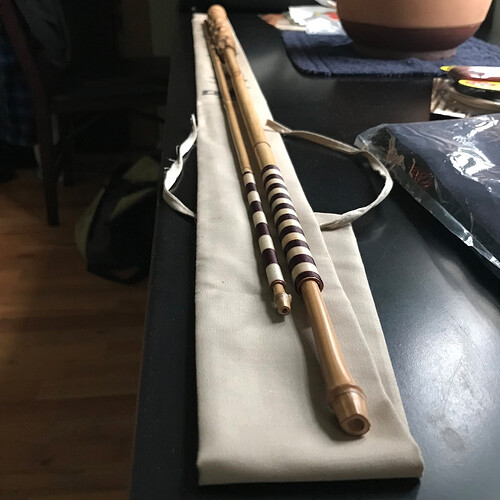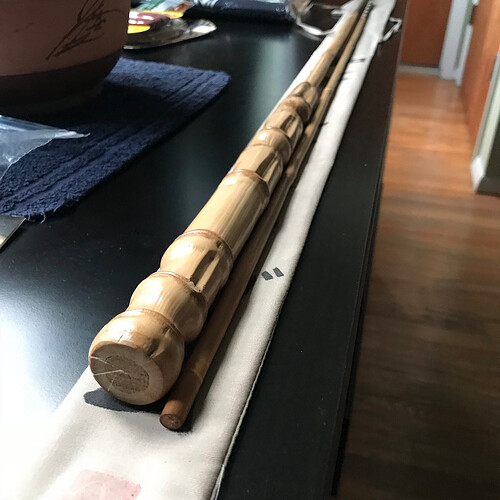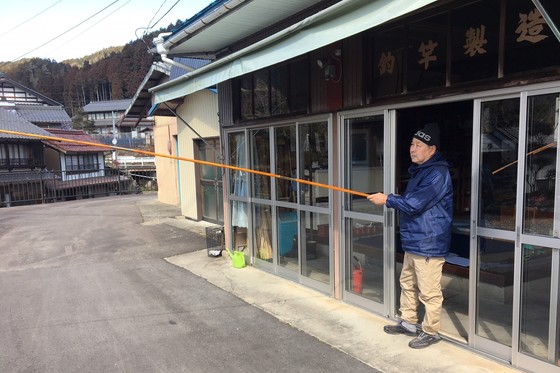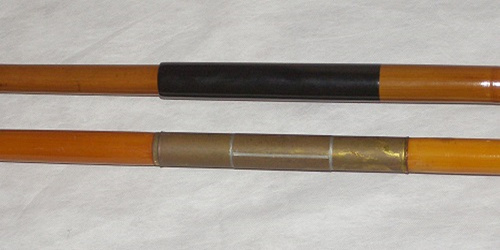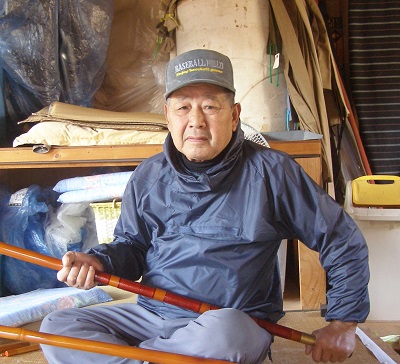I wanted to start a topic on Wazao and bamboo rods. I had the pleasure of spending a day with Yamano-san and Go-san while in Japan in February. I learned about Wazao and got to make a very simple bamboo tenkara rod that was doable in one day.
I have so far built a horse hair line for this rod. 4 hair thickness and level. Season opens soon here in NY so I will be trying it out on the water soon. Total length of this rod is only 7 feet but it actually flexes fairly softly. Go-san was able to cast 4 meters of #4 level line with it…so…
Are people here interested in this craft? Does anyone own a rod?
I do not own a bamboo tenkara rod. But find them interesting to read about.
Is this the same rod maker that taught, I think Isaac Tait and maybe also the Discover Tenkara guys, how a bamboo rod is made?
Ah, here it is. I think it’s the same person.
https://www.fallfishtenkara.com/herabuna/
http://www.discovertenkara.com/blog/blog-31.html
Oh, and I found these two links while looking for the other links.
http://www.discovertenkara.com/blog/adam-rieger-japan-diary.html
http://www.discovertenkara.com/blog/adam-rieger-japan-diary-2.html
I have to agree with what was stated in the above blog post, about Go rigging up a 3.6m rod with 6m line. Like you Adam I rarely fish with a line that much longer than the rod. About the longest line I use with a 4m rod is 5.5m, but prefer 4.5m or 5m line, + tippet. [ So about a maximum of 1.25x or 1.38x rod length. And sometimes a line 1x rod length or shorter. And even more rarely I will fish with a 6m line, just to try it out once in a while]
But like Go I think you can improve your casting of shorter lines by doing some casting training with a long line. Up to 8m line with a 4m rod is sufficient, I think. I also think tenkara beginners’ casting would benefit by doing some casting early on with a longer line, maybe a 6m #4 line as soon as they can cast a line equal to rod length fairly well. It will reveal poor timing and rhythm quickly.
Anyway, lately I’ve been distracted by some of my other interest absorbing my time, and need to get back to making a 4-hair horse hair level line. Actually two lines, of about 4m, I want to make one for a friend before I mail him another item.
For those interested, this video of @arieger building his rod will be in the next issue of Tenkara Angler magazine… which will hit the “virtual” newsstand on Monday 4/2.
Cool. Thanks Michael.
There is a slight typo for the URL at the end of the video.
An ‘s’ and ‘o’ got reversed. saosyosaku , not sasoyosaku. (Happens to all of us)
山野 正幸さん [Yamano Masayuki-san ]
山野和竿店 [Yamano wasao-ten (shop/store)]
For the Facebook inclined.
https://ja-jp.facebook.com/masayuki.yamano.77
The better choice:
https://www.facebook.com/saoshou/
ニッポン手仕事・図鑑 × 竿昭作(山野正幸)
Japan handcraft, picture book × SaoShosaku (Masayuki Yamano)
Yamano Masayuki 山野正幸 YouTube channel , video page, there are 10 videos uploaded:
These internet search phrases work fairly well to find more links:
和竿・山野 正幸さん [ wasao Yamano Masayuki-san]
和竿・手仕事 [ wasao teshigoto (handicraft, handwork]
手作りの和竿 [tedzukuri no wasao, handmade wasao]
Both of these two phrases only find a few Tenkara bamboo pole specific links, but they find other fun stuff & slightly different search results:
手作り・テンカラ竹竿 [ tedzukuri Tenkara takezao, handmade tenkara bamboo pole]
テンカラ竹竿を手作り [ Tenkara takezao o tedzukuri , tenkara bamboo pole hand made]
@dwalker this is awesome thanks for all the links making this a nice reference page. Indeed this is the same Yamano-san that Isaac and the DT guys wrote about.
@FallfishTenkara (if my reading of his last blog entry is correct) is super busy so it might be a while before he chimes in. He, I believe, did 2 rods. One like me which was a simple bamboo rod project that really shows you how to make a joint (male and female ends) then he also did a true Wazao rod. To do a true Wazao rod is a much longer term investment and takes a lot of time. Perhaps one day he will do a full write up of his experiences. I did get a glimpse of his rod at the shop while it was in progress…it was being lacquered using Urushi which Yamano-san has, since he was a child, built up a tolerance to its allergic reaction. Isaac’s rod is gorgeous!!! I look forward to seeing pictures of it completed.
Yamano’s skill and craft is sadly becoming more and more rare in Japan. It is potentially something that faces extinction (sorry to be dramatic!). How to change that I really do not know exactly…? But I figure I should at least talk about it and share on it with people that might be interested and some day someone smarter than me will help save it.
Western bamboo rod builders do not seem to face the same fate? Perhaps an exchange among skilled craftsman could help?
I hope to be able to fish it soon. I need a day where I can get to a very clear spot with few obstacles - (I know a spot ;)) so I minimize any risk of damage. Snow is coming here tomorrow so I am delayed! ![]()
In practical “wazao” there is “郡上竿”
There is an “郡上竿” introduction to this blog
https://blogs.yahoo.co.jp/fk3yi8anpontan/folder/1281589.html
Manufacturer contact
manufacturer
The secret of the strength of “Gujo Rod”
On the photo “Kanto rod” The bottom photo is “Gujo Rod”
The fitting is made of brass tube
There is a difference between arts and utility goods
I would recommend “Gujo Rod” if I
Because it keeps practicality and strength brought up by fishermen
I’ve a few corrections to make yet (kirikomi rather than kirikumi for instance), but if you’re interested you can preview my rough article on Japanese bamboo rods, wazao shokunin, Masayuki Yamano and Adam Rieger too…
Chris Stewart posted this story a year or so back.
https://craftsmanship.net/bamboo-take-two-japans-gorgeous-precarious-fishing-poles/
I wouldn’t say you can’t stop progress. Rather I’d say time, fashion, and economies change. How can traditional craftsmanship survive in the modern world is a question being asked by many people.
Many crafts may become extinct, a few crafts may survive in museums, but not as a thriving business.
I recall reading a book about quality assurance years ago, and how it effects business. Zero defects and products of a high standard was described as a dead end road. I recall one example from the book. A buggy whip company realized their business was declining and came up with a plan to reverse the decline, and once again thrive. The owner hired brilliant designers, sourced the highest qualities materials, improved training, improved his quality control program, and many other innovations. Yet his business still declined. The problem was it was the wrong product. He failed to talk to potential customers and find out what they needed and wanted. Making the best buggy whip in the world didn’t help because Ford had introduced the assembly line, and cars were replacing horse drawn buggies. Supplying a better buggy whip wasn’t going to defeat the decline in need for them. Sad to see old crafts, refined over hundreds of years for many products, fade away, but there you are. It’s difficult to sell a $4,000 rod, when one that it many ways out performs the old technology that cost less than $400. In a world where today a car cost as much as house did 40 years ago. I could blame that on the Federal Reserve for its many sins. But it won’t make small traditional craft shop thrive.
These were also kind of an interesting reads.:
https://craftsmanship.net/bamboo-take-two-japans-gorgeous-precarious-fishing-poles/
https://www.prophet.com/2012/09/back-to-basics/
Above the Back-to-Basics title was Lessons from 21st Century Craftsmen. It presented some interesting innovation ideas to capture customers, but he was still mostly focusing on the same idea as the buggy whip business owner, focusing on the product. Believing that he is keeping the customer in mind when he focuses on making a high quality authentic product. That may work for a few craft shops, but not a lot of shops.
Anyway, Yamano Masayuki 山野正幸 website seems to be aware of the need to reach out to foreign customers. Which might help in a world where some, a few people at least, are willing to pay the cost of the limited production Tenryu TF39 Beccho rod. Innovative, high craftsmanship, and high cost, though I don’t at the moment recall the price, but a lot higher than than any other tenkara rod I recall reading about. I don’t think anyone is buying the Tenryu TF39 Beccho rod, just to fish with it, they’re willing to pay for something with a refined traditional craft integrated into it.
Maybe the Wazao rod makers can survive by figuring out how to adopt their skills to modern materials, as Tenryu had done with the Kyoto weavers. Find a way to merge their skills into other types of rods, thereby retaining an evolution of their skills into modern world.
Well, gotta go. The family is calling to remind me Easter dinner is waiting for me to show up.
Oops… nice catch! I’ve fixed and re-uploaded the video. Thanks @dwalker!
Maybe I should hire you to be the spell-checker for Tenkara Angler… my eyes go so buggy after a while - HA!
[quote=“Paul_Gaskell, post:9, topic:762”]
I’ve a few corrections to make yet …, but if you’re interested you can preview my rough article on Japanese bamboo rods, wazao shokunin,…[/quote]
Paul,
This is off topic of this thread, well, mostly. Maybe not entirely.
On the DT website on the Tenkara: The Full Lowdown webpage and on the bamboo-tenkara-rod webpage you wrote:
" In Japan a “Shoku-nin” ( 職人) is a person who has complete mastery over their profession.
+
Examples of how the word “shokunin” is used include:
Sushi-shokunin: Sushi chefs of very high standards
Wagashi-shokunin: Japanese traditional pastry chef
Urushi-shokunin: Urushi lacquer craftsmen
Wazao-shokunin: Traditional Japanese bamboo fishing rod builder …"
In TiF Episode 1: You interviewed Yamada san, about the Shokuryoshi, and also wrote about him on the Tenkara: The Full Lowdown, you also wrote about - 67-year-old Kazuyuki Yamada (Yamada-san)…a third generation Shokuryoshi…
A couple of weeks ago I got to thinking about him and Aikiyamago, and did a google search with - 山田さんの秋山郷 (Yamada-san no Akiyama Gō). I was surprised to see most of the search results were not about tenkara, but were instead websites showing 山田和幸さん ( Yamada Kazuyuki-san) making large wooden bowls or pots. [木鉢 , Kibachi] Such as these two websites, which I am almost certain is the same man:
http://special.sakae-akiyamago.com/still/detail.php?i=5
And
秋山の木鉢を作る・最後の職人 [ Akiyama no Kibachi o tsukuru saigo no shokunin, Making Akiyama wooden pot of · The last craftsman]
http://www.iijan.or.jp/oishii/area/north/post-2382.php
If I haven’t misidentified the man making the bowls, it would seem that Yamada Kazuyuki-san, is a double Shoku-nin. Shokuryoshi for tenkara fishing & a 木鉢・職人 . [Kibachi shokunin].
An unexpected aspect of Yamada Kazuyuki-san, I don’t recall reading about. Or maybe I’m off on another of my lost in the forest sojourns and the two are not the same person, but two different men, with similar names and appearance. ![]()
Lost or not, it’s another story about the last craftsman from a small village, making a different product.
Can’t say I disagree with stopping progress or your points…they are true of course.
Whether or not a graphite rod is better than a bamboo one…well I’ll tell you my thoughts at the end of this season ![]()
Tenkara or Fixed line fishing is a great example of being careful what you wish for in the name of “progress”. Many things we find we want to progress past…but we come back to the “old ways” as better.
I would also toss out there that often things disappear and become expensive because cheap and poor facsimiles are marketed better and consumers lack the knowledge to discern the difference.
But at the end of the day it is what it is…if no one values it then it will indeed disappear. I hope it does not disappear but I am not unrealistic and think it will replace cheaply made graphite facsimiles.
Today I got about 1 hour in of lawn casting with several different horse hair lines and lengths and tapers. I learned a little bit of the “personality” of my bamboo rod and was able to in short time tweak my cast to deliver any line the way I wanted. I was both impressed with its ability and thoroughly enjoyed its immediate need for personification. I know we all do this with the rods we love…but there is no doubting this rod has “personality” and I feel like it has the personality to help me out :). I am now going to obviously have to give the rod a name…but what name…?
The correct name is ”山田和幸”・・・It is the same person.
In Akiyama village we can not work outside with snow for nearly half a year
They made various tools in the house during the winter
I think that hand tools are what I can satisfy
Thing is the hand tools that are made according to their own preferences and applications
“Tenkara-toos” is also the same hand tools
Top sleuthing as usual David! It is indeed the same man. I kept a leaflet that Yamada san had published about his hand made wooden bowls so I’ll photograph that when I get chance.
I believe the bowls may be the major source of his income, though - as with wazao shokunin - it is incredibly difficult to find apprentices to carry on the tradition.
Go Ishii has been working with a variety of traditional Japanese craftsmen and women (from ceramics to wood carving and bamboo) to help promote and preserve their arts.
P
I think the point that is difficult to convey in written communication is that progress isn’t always progress, maybe it is just change. Comparing a well made wazao rod to graphite, CF rod maybe like comparing peaches and nectarines, or a horse hair line and a furled line made of different materials, kind of the same, but different, each having their own advantages and disadvantages. And each can be enjoyed for different reasons. A new Fujino furled line probably requires less care than a horse hair line, but horse hair lines are said to have unique casting qualities that some people favor over a line made of synthetic materials. And of course their is the fun of catching a fish with a bamboo rod, horse hair line and a kebari all made by yourself.
Bamboo rods are, I think, mostly heavier than rods made of modern materials, and the flex characteristics are different. Mostly we think of casting with the correct rhythm to allow the flex of the rod to cast the line. But it was interesting to read on a website recently that the weight of the Gujo rod enabled a short casting stroke. I don’t recall which website where I read that. I think it was the Fishing-Cafe website, but it may have been a different website. Makes sense though that you can cast a line using different source of energy from a rod, spring energy from flexing of the rod, or energy from weight. I’m sure there is an overlap of the two types of energy to find the sweet spot that allows each type of rod to cast well. Each will have its own rhythm or tempo to cast efficiently.
I can see how that is true. Three weekend ago it snowed here. My house is at an altitude of about 700 ft (~213m) we had about 5 inches of snow. Four hours at our vacation house the altitude is about 2,200 ft, were there was about 12 inches of snow. But about 15 miles from there on Cheat Mountain the altitude is about 4,850ft (1,478m) they had 56 inches (1.4m) of snow. A small change of altitude can make a huge difference in the amount of snowfall over the winter.
The mountains of Japan are much higher than Cheat Mountain.
https://en.wikipedia.org/wiki/List_of_mountains_and_hills_of_Japan_by_height
From what I have read Akiyamgo is quite isolated. Has it’s own dialect. Often completely cut of during the winter months.
wikipedia Akiyamago Dialect
Paul and Todoroki-san, thank you for confirming I wasn’t confusing two different people.
The Akiyama wood bowls (秋山木鉢) have their own wikipedia page.
The Wikipedia page for Akiyama gō tells a lot more about the situation there. Where among other things the area is known for it’s hot springs, and another craft item, a type of cat house, of the pet type, ![]() , called a 猫つぐら (nekotsu gura), Neko being the Japanese word for “cat”.
, called a 猫つぐら (nekotsu gura), Neko being the Japanese word for “cat”.
Go Ishii-san is a busy man, I hope he has success finding a way to adapt and preserve many of those craft in current circumstances. (similar in some ways to the Grandma’s Recipes thread elsewhere on this forum. About traditional way of living)
I’m sorry for dragging this thread again away from being about Wazao, but I thought this was an interesting video, of what seems to be a master bowl maker teaching a young woman how to make a similar type of wooden bowl. In this case a 「こね・鉢」kone hachi, Kneading bowl, I guess. Another traditional craft product, 伝統工芸品 (dentōkugei-hin).
The 9 part series about making a homemade Wazao, 和竿の自作!, tenkara pole is interesting to look through. The series started last March 2017.
Since the digital translation is often weird, and sometimes blacks out a picture or video on the page, below are direct links to the different parts.
Introduction page, 和竿の自作!・ロマンを求めて, Wazao homemade! ・Seeking romance ??
tenkara-beginner 和竿の自作!・ロマンを求めて
Part 1 : テンカラ和竿の製作記①工程の確認, Tenkara Wazao pole production description/notes ① Confirm process
tenkara-beginner テンカラ和竿の製作記①工程の確認
Part 2: becomes a little more interesting with pictures and not just text.
テンカラ和竿の製作記②設計図、切り組み, Tenkara Wazao pole production description ② Design drawing, Structures
tenkara-beginner テンカラ和竿の製作記②設計図、切り組み
Part 8: テンカラ和竿製作記⑧完成、・そして反省編, Tenkara Wazao pole production notes ⑧ Completion, · and reflection
tenkara-beginner テンカラ和竿製作記⑧完成、・そして反省編
Parts 3 ~ 7 are linked to toward the bottom of the pages, under the あわせて読みたい記事:banner, articles to be read together.
It was quite an attractive tenkara pole when completed, but had several quirks, ah, character features, ![]()
https://tenkara-beginner.net/wp-content/uploads/2017/05/IMG_5011-1024x768.jpg
An amateur beginner rod builder can’t match the quality of a rod made by a master rod maker, but many people might find it a fun project, to do and to fish with.
Perhaps similar to amateur radio guys, most of them can’t build transceivers to match the function of factory made ones (only a few can), yet many like to build their own, some design and build simple radios, particularly the QRP (low power, mostly Morse code) advocates , or from kits of sophisticated designs made by others. I wonder if any rod makers, with stores of seasoned bamboo, have considered offering rod kits as a possible side business? However, rapid humidity and temperature changes of unsealed bamboo might be a major problem, leading to splitting of the bamboo, or other problems making it an unfeasible idea.
Great work @dwalker and thanks for sharing.
